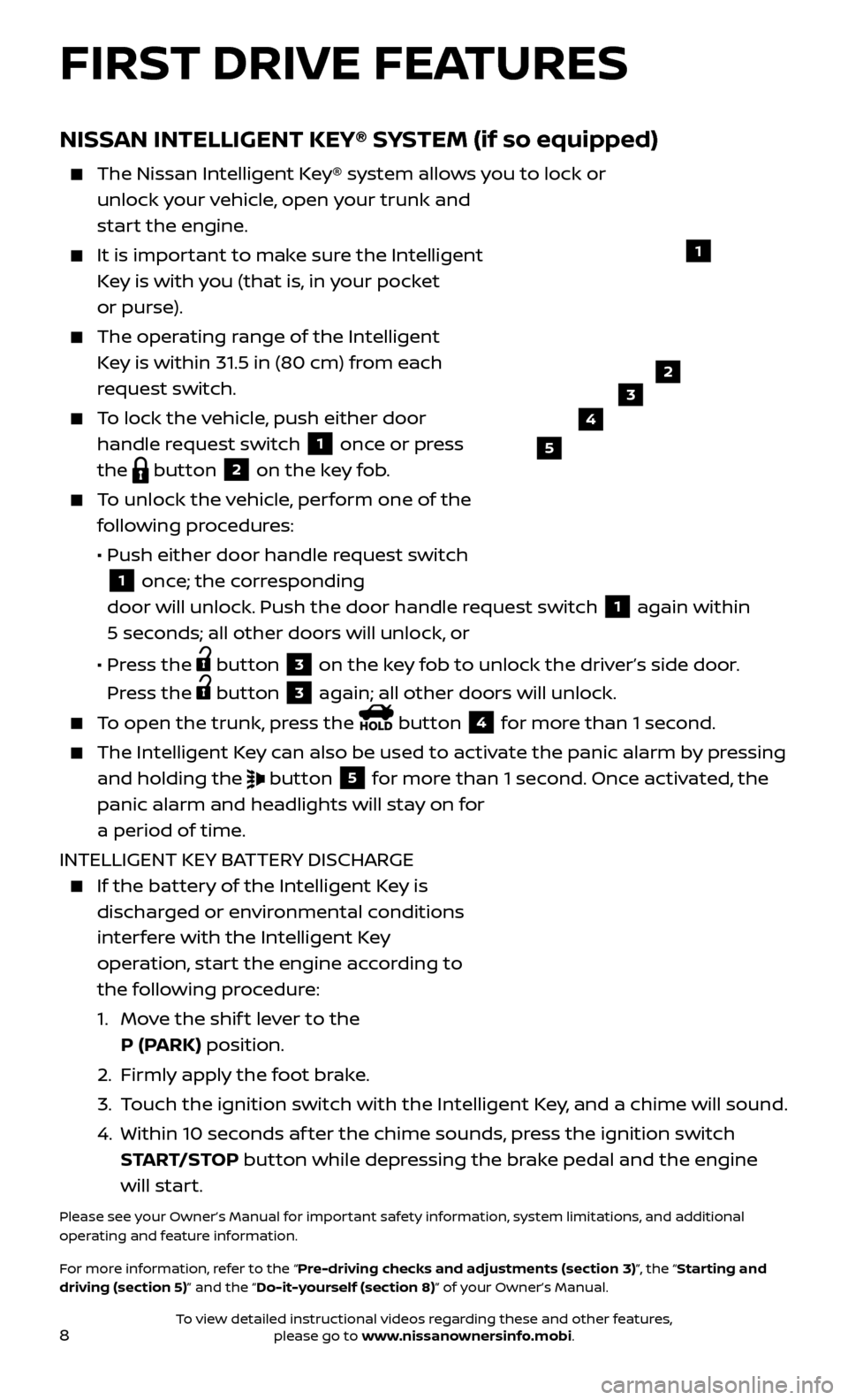2017 NISSAN VERSA SEDAN ignition
[x] Cancel search: ignitionPage 4 of 30

2
REARVIEW MONITOR (if so equipped)
When the shift lever is moved to the
R (REVERSE) position, the front display
shows the view to the rear of the vehicle.
The colored lines on the display screen indicate approximate distances to objects.
•
R
ed 1.5 f t (0.5 m); Yellow 3 f t (1 m);
Green 7 f t (2 m) and 10 f t (3 m).
Please see your Owner’s Manual for important safety information, system limitations, and additional
operating and feature information.
For more information, refer to the “Monitor, climate, audio, phone and voice recognition systems
(section 4)” of your Owner’s Manual.
NEW SYSTEM FEATURES
TRIP COMPUTER
With the ignition switch in the ON
position, modes of the trip computer
1 can be selected by pressing the trip
computer change/reset button
2 on the
instrument panel.
The following modes can be selected in the display:
•
ODO
– records the total distance the
vehicle has been driven.
•
T
rip A – measures the distance of one specific trip.
•
T
rip B – measures the distance of a second specific trip.
• mpg
– displays the instant fuel consumption.
• mpg A
VG – displays the average fuel consumption since the last reset.
•
mls
– displays the estimated distance that can be driven
before refueling.
•
Outside Air
Temperature (if so equipped) – displays the outside air
temperature in °F or °C.
To reset T rip A, Trip B, mpg or mpg AVG, go to the desired mode on the trip
computer and press and hold the trip computer change/reset button
2
for more than 3 seconds.
Please see your Owner’s Manual for important safety information, system limitations, and additional
operating and feature information.
For more information, refer to the “Instruments and controls (section 2)” of your Owner’s Manual.
1
2
To view detailed instructional videos regarding these and other features, please go to www.nissanownersinfo.mobi.
Page 6 of 30

4
ESSENTIAL INFORMATION
TIRE PRESSURE MONITORING SYSTEM (TPMS)
WITH EASY-FILL TIRE ALERT (if so equipped)
A CHECK TIRE PRES warning message will appear in the trip computer 1
and the low tire pressure warning light
2 will illuminate when one or more
tires are low in pressure and air is needed.
• The tir
e pressures should be checked
when the tires are cold. The tires are
considered cold af ter the vehicle has been
parked for 3 hours or more or driven less
than 1 mi (1.6 km) at moderate speeds.
Af ter the tire pressures are adjusted, drive the vehicle at speeds above 16 mph
(25 km/h). The CHECK TIRE PRES warning
message and low tire pressure warning light
2 will extinguish.
When adding air to an under -inflated tire, the TPMS with Easy-Fill Tire Alert
(if so equipped) provides visual and audible signals to help you inflate the
tire to the recommended COLD tire pressure.
T
o use the Easy-Fill Tire Alert (if so equipped):
1.
Mo
ve the shif t lever to the P (PARK) position and apply the parking brake.
2. Plac
e the ignition switch in the ON position. Do not start the engine.
3.
A
dd air to the under-inflated tire, and within a few seconds, the hazard
warning lights will start flashing.
4.
When the designated tir
e pressure is reached, the horn will beep once
and the hazard warning flashers will stop flashing.
5
.
R
epeat this procedure for any additional under-inflated tires.
When the lo w tire pressure warning light 2 flashes for 1 minute and then
remains on, the TPMS is not functioning properly. Have the system checked.
It is recommended you visit a Nissan dealer for this service.
Tire pressure rises and falls depending on the heat caused by the vehicle’s operation and the outside temperature. Low outside temperature can
lower the temperature of the air inside the tire, which can cause a lower tire
inflation pressure. This may cause the low tire pressure warning light
2 to
illuminate. If the warning light illuminates, check the tire pressure in your tires.
•
Check the tir
e pressure (including the spare tire) of ten and always prior to
long distance trips.
The Tire and Loading Information label contains valuable information. Please refer to the “Technical and consumer information (section 10)” of your
Owner’s Manual for the location of the Tire and Loading Information label.
Please see your Owner’s Manual for important safety information, system limitations, and additional
operating and feature information.
For more information, refer to the “Instruments and controls (section 2)”, the “Starting and driving
(section 5)” and the “Do-it-yourself (section 8)” of your Owner’s Manual.
1
2
To view detailed instructional videos regarding these and other features, please go to www.nissanownersinfo.mobi.
Page 10 of 30

8
NISSAN INTELLIGENT KEY® SYSTEM (if so equipped)
The Nissan Intelligent Key® system allows you to lock or
unlock your vehicle, open your trunk and
start the engine.
It is impor tant to make sure the Intelligent
Key is with you (that is, in your pocket
or purse).
The oper ating range of the Intelligent
Key is within 31.5 in (80 cm) from each
request switch.
To lock the vehicle, push either door handle request switch
1 once or press
the
button 2 on the key fob.
To unlock the vehicle, perform one of the following procedures:
•
Push either door hand
le request switch
1 once; the corresponding
door will unlock. Push the door handle request switch
1 again within
5 seconds; all other doors will unlock, or
•
Pr
ess the
button 3 on the key fob to unlock the driver’s side door.
Press the
button 3 again; all other doors will unlock.
To open the trunk, press the button 4 for more than 1 second.
The Intel ligent Key can also be used to activate the panic alarm by pressing
and holding the
button 5 for more than 1 second. Once activated, the
panic alarm and headlights will stay on for
a period of time.
INTELLIGENT KEY BATTERY DISCHARGE
If the bat tery of the Intelligent Key is
discharged or environmental conditions
interfere with the Intelligent Key
operation, start the engine according to
the following procedure:
1.
Mo
ve the shif t lever to the
P (PARK) position.
2.
Firml
y apply the foot brake.
3.
T
ouch the ignition switch with the Intelligent Key, and a chime will sound.
4.
Within 10 sec
onds af ter the chime sounds, press the ignition switch
START/STOP button while depressing the brake pedal and the engine
will start.
Please see your Owner’s Manual for important safety information, system limitations, and additional
operating and feature information.
For more information, refer to the “Pre-driving checks and adjustments (section 3)”, the “Starting and
driving (section 5)” and the “Do-it-yourself (section 8)” of your Owner’s Manual.
23
4
5
1
FIRST DRIVE FEATURES
To view detailed instructional videos regarding these and other features, please go to www.nissanownersinfo.mobi.
Page 12 of 30

10
STARTING/STOPPING THE ENGINE
STARTING THE ENGINE
It is important to make sure the Intelligent
Key is with you (that is, in your pocket
or purse).
CONTINUOUSLY VARIABLE TRANSMISSION
(Nissan Intelligent Key® models only –
if so equipped)
Depress the brake pedal.
•
If the br
ake pedal is not depressed,
pushing the ignition switch once enters the ACC mode.
•
If the ignition switch is pushed a sec
ond time, the vehicle will enter the
ON mode.
Move the shif t lever to the P (PARK) position.
Press the ignition switch START/STOP button to start or stop the engine.
CONTINUOUSLY VARIABLE
TRANSMISSION/AUTOMATIC/MANUAL
TRANSMISSION (if so equipped)
Depress the brake pedal.
Move the shif t lever to the N (NEUTRAL) position (automatic transmission only).
Depress the clutch pedal to the floor (manual transmission only).
Turn the ignition switch to the S TA R T position.
TURNING THE ENGINE OFF
For a Continuously Variable Transmission (Nissan Intelligent Key® models only – if so equipped), apply the brake pedal, move the shif t lever to the
P (PARK) position, apply the parking brake and press the ignition switch
START/STOP button to turn the engine off.
For a manual transmission, apply the brake pedal, place the vehicle in 1 (FIRST) gear, apply the parking brake and turn the ignition switch to the
LOCK position.
For the automatic transmission and Continuously Variable Transmission, apply the brake pedal, move the shif t lever to the P (PARK) position, apply
the parking brake and turn the ignition switch to the LOCK position.
Please see your Owner’s Manual for important safety information, system limitations, and additional
operating and feature information.
For more information, refer to the “Starting and driving (section 5)” of your Owner’s Manual.
FIRST DRIVE FEATURES
To view detailed instructional videos regarding these and other features, please go to www.nissanownersinfo.mobi.